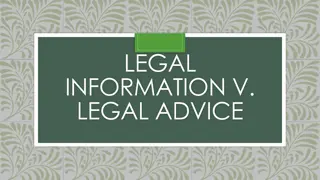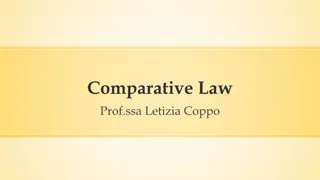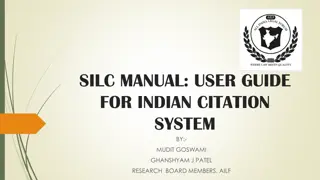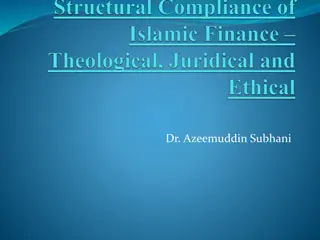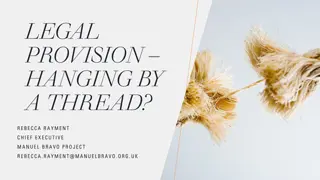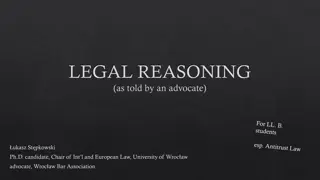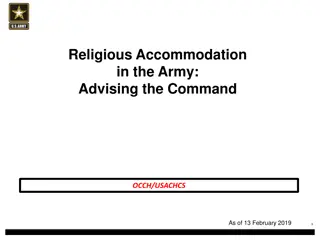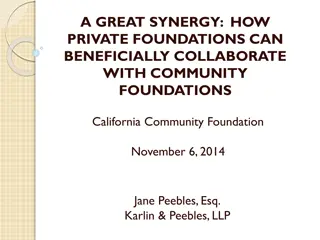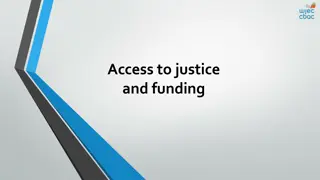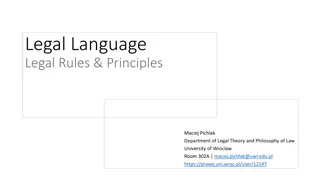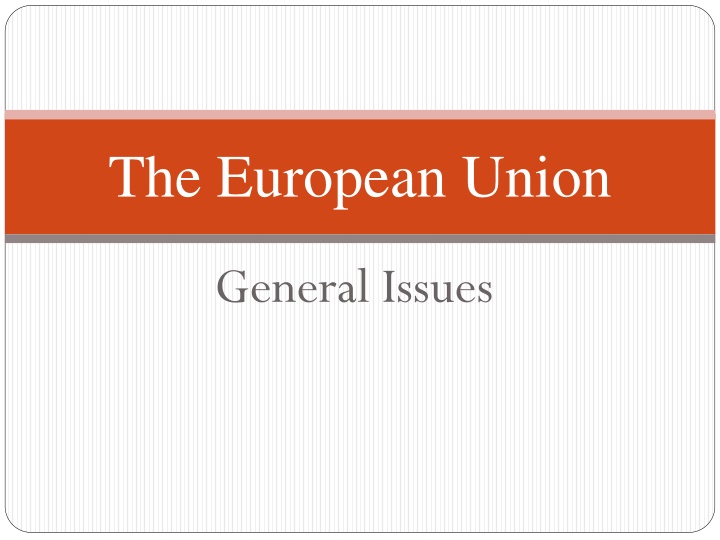
European Union: Key Facts, History, and Treaties Revealed
Explore the European Union's origins post-World War II, its evolution into a political and economic union with 27 member states, key policies promoting free movement, its internal market, and major treaties like the Maastricht and Lisbon Treaties reshaping its structure. Dive into this comprehensive overview shedding light on the EU's economic cooperation, lasting impact, and future implications.
Download Presentation

Please find below an Image/Link to download the presentation.
The content on the website is provided AS IS for your information and personal use only. It may not be sold, licensed, or shared on other websites without obtaining consent from the author. If you encounter any issues during the download, it is possible that the publisher has removed the file from their server.
You are allowed to download the files provided on this website for personal or commercial use, subject to the condition that they are used lawfully. All files are the property of their respective owners.
The content on the website is provided AS IS for your information and personal use only. It may not be sold, licensed, or shared on other websites without obtaining consent from the author.
E N D
Presentation Transcript
The European Union General Issues
Part One Key facts and figures
Introduction The European Union (EU) is a political and economic union of 27 member states that are located primarily in Europe. It has an area of 4,475,757 km2, and an estimated population of over 446 million. The EU has developed an internal market through a standardised system of laws that apply in all member states. EU policies aim to ensure the free movement of people, goods, services, and capital within the internal market. Within the Schengen Area, passport controls have been abolished. A monetary union was established in 1999 and came into full force in 2002, and is composed of 19 EU member states which use the euro currency.
Introduction The predecessor of the EU was created in the aftermath of the Second World War. The integration process had started with the Schuman- Declaration of 9 may 1950, which was the impetus for developing the Treaty establishing the European Coal and Steal Community (ECSC-Treaty) of 18 April 1951. The Schuman-Declaration had created the basic concepts which were fundamental for the process of European integration: its architectural plan of instituting supra-nationality by the transfer of powers from States to a confederation.
Introduction The first steps were to foster economic cooperation: the idea being that countries that trade with one another become economically interdependent and so more likely to avoid conflict. The result was the European Economic Community (EEC), created in 1958, and initially increasing economic cooperation between six countries: Belgium, Germany, France, Italy, Luxembourg and the Netherlands.
Maastricht Treaty (1992-2007) The next step in the process of enhancing a closer European integration was taken by the 12 EEC Member States by signing the Treaty on the European Union at Maastricht on 7 February 1992. The European Union was formally established when the Maastricht Treaty came into force on 1 November 1993. The treaty also gave the name European Community to the EEC, even if it was referred as such before the treaty.
Lisbon Treaty ( 2007-present) On 13 December 2007 the new EU Reform Treaty of Lisbon was signed by the representatives of the Member States. On 1 December 2009, the Lisbon Treaty entered into force and reformed many aspects of the EU. It changed the legal structure of the European Union, merging the EU three pillars system into a single legal entity provisioned with a legal personality, It created a permanent President of the European Council, It strengthened the position of the High Representative of the Union for Foreign Affairs and Security Policy
Lisbon Treaty ( 2007-present) the European Charter of Fundamental Rights become legally binding by a normative reference in Article 6 TEU; transferred police and judicial cooperation in criminal matters into the new Title V Area of Freedom, Security and Justice of Part III of the supranationality structured TFEU; in order to provide the possibility for a group of Member States to proceed faster to the goal of a closer integration, the enhanced cooperation (Article 20TEU) among them was introduced.
Economic indicators The EU as a whole is the largest economy in the world. The EU in 2017 generated a nominal gross domestic product (GDP) of 15.875 trillion US dollars, constituting approximately 35.5% of global nominal GDP. Together with the United States and China, the EU is one of the 3 largest global players in international trade.
EU Institutional System The EU operates through a hybrid system of supranational and intergovernmental decision-making. The seven principal decision-making bodies known as the institutions of the European Union are the European Council, the Council of the European Union, the European Parliament, the European Commission, the Court of Justice of the European Union, the European Central Bank, and the European Court of Auditors.
The Nobel Peace Prize In 2012, the EU received the Nobel Peace Prize for having "contributed to the advancement of peace and reconciliation, democracy, and human rights in Europe."
Demographics The EU covers over 4 million km and has 446 million inhabitants - the world s third largest population after China and India. By surface area, France is the biggest EU country and Malta the smallest.
Languages The EU has 24 official and working languages: Bulgarian, Croatian, Czech, Danish, Dutch, English, Estonian, Finnish, French, German, Greek, Hungarian, Italian, Irish, Latvian, Lithuanian, Maltese, Polish, Portuguese, Romanian, Slovak, Slovene, Spanish, and Swedish. Important documents, such as legislation, are translated into every official language.
Religion Self described religion in the European Union (2017) Catholic (48%) Protestant (12%) Orthodox (8%) Other Christian (4%) Non believer/Agnostic (16%) Atheist (7%) Muslim (2%) Other religion/None stated (3%)
Religion-Article 17 TFEU The EU has no formal connection to any religion. The EU respects the "status under national law of churches and religious associations or communities in the Member States . Recognising their identity and their specific contribution, the Union maintains an open, transparent and regular dialogue with these churches and organisations.
Religion-Article 17 TFEU It contains aspects of a collective right to freedom of religion. Article 17(1) recognises the various organisational forms of religious communities that can be found and are legally accepted within the EU Member State. Article 17(2) guarantees the same status and the same protection to philosophical and non-confessional organisations. A duty to respect and the duty not to prejudice. It contains a prohibition of a legal harmonisation which prevents the EU from introducing even minor legislative acts concerning religion and religious communities.
Symbols The flag of the Union consists of a circle of 12 golden stars on a blue background. The blue represents the West, while the number and position of the stars represent completeness and unity, respectively. Originally designed in 1955 for the Council of Europe, the flag was adopted by the EC, in 1986. Since 1985, the flag day of the Union has been Europe Day, on 9 May (the date of the 1950 Schuman declaration).
Symbols The anthem of the Union is an instrumental version of the prelude to the Ode to Joy, the 4th movement of Ludwig van Beethoven's ninth symphony. The anthem was adopted by European Community leaders in 1985 and has since been played on official occasions.
The EU motto United in Diversity was adopted as the motto of the Union in the year 2000, having been selected from proposals submitted by school pupils. It signifies how Europeans have come together, in the form of the EU, to work for peace and prosperity, while at the same time being enriched by the continent's many different cultures, traditions and languages.
Europe Day Europe Day held on 9 May every year celebrates peace and unity in Europe. The date marks the anniversary of the historical 'Schuman declaration'. At a speech in Paris in 1950, Robert Schuman, set out his idea for a new form of political cooperation in Europe, which would make war between Europe s nations unthinkable.
EU citizenship All citizens of an EU country are automatically citizens of the EU. Being an EU citizen gives us some important extra rights and responsibilities. Moving & living in the EU: As an EU citizen, you have the right to live and move within the EU without being discriminated against on the grounds of your nationality. Participating in the political life of the EU: Every EU citizen has the right to vote and stand as a candidate in both local and European elections in the EU country they live in, under the same conditions as nationals of that country.
EU citizenship EU citizenship Petitions & complaints: You can petition the European Parliament to address either a personal need, or on a matter of public interest. The subject must fall within the EU s remit (i.e. it mustn t be something that is decided at local or national level) and must affect you directly.You can complain to the European Ombudsman about misconduct by an EU institution or body. Consular protection: If you are in a non-EU country and need help, as an EU citizen you are entitled to consular protection from the embassy or consulate of any other EU country, if your own country does not have an embassy or consulate in the non-EU country.You can ask for assistance in situations involving, for example, death, accident or illness, arrest or detention, being the victim of violent crime and repatriation.
The Euro The euro is the official currency for 19 of the 27 EU member countries. A long preparatory path of over 40 years led to the introduction of the euro in 2002. The European Central Bank and the European Commission are in charge of maintaining its value and stability, and for establishing the criteria required for EU countries to enter the euro area.
From economic to political union What began as a purely economic union has evolved into an organization spanning policy areas, from climate, environment and health to external relations and security, justice and migration. The EU is based on the rule of law: everything it does is founded on treaties, voluntarily and democratically agreed by its member countries. The EU is also governed by the principle of representative democracy, with citizens directly represented at Union level in the European Parliament and Member States represented in the European Council and the Council of the EU.
Human rights and equality One of the EU's main goals is to promote human rights both internally and around the world. Human dignity, freedom, democracy, equality, the rule of law and respect for human rights: these are the core values of the EU. Since the Lisbon Treaty's entry in force in 2009, the EU's Charter of Fundamental Rights brings all these rights together in a single document. The EU's institutions are legally bound to uphold them, as are EU governments whenever they apply EU law.
From 6 to 27members In 1951, six countries founded the European Coal and Steel Community, and later, in 1957, the European Economic Community and the European Atomic Energy Community: Belgium, Germany, France, Italy, Luxembourg and the Netherlands A further 22 countries have since joined the EU, including a historic expansion in 2004 marking the re-unification of Europe after decades of division. The United Kingdom withdrew from the European Union on 31 January 2020.
Part II History
The The history of the European Union history of the European Union 9 May 1950 French Foreign Minister Robert Schuman presents a plan for deeper cooperation. Later, every 9 May is celebrated as ' Europe Day'. 18 April 1951 Based on the Schuman plan, six countries sign a treaty to run their heavy industries coal and steel under a common management. In this way, none can on its own make the weapons of war to turn against the other, as in the past. The six are Germany, France, Italy, the Netherlands, Belgium and Luxembourg.
The history of the European Union The history of the European Union 25 March 1957 Building on the success of the Coal and Steel Treaty, the six countries expand cooperation to other economic sectors. They sign the Treaty of Rome, creating the European Economic Community (EEC), or common market . The idea is for people, goods and services to move freely across borders. 1 July 1968 The six remove customs duties on goods imported from each other, allowing free cross-border trade for the first time. They also apply the same duties on their imports from outside countries. The world s biggest trading group is born. Trade among the six and between the EU and the rest of the world grows rapidly.
The history of the European Union The history of the European Union 24 April 1972 The EU s first plan for a single currency dates from 1970. To maintain monetary stability, EU members decide to allow their currencies to fluctuate against each other only within narrow limits. This exchange rate mechanism (ERM), created in 1972, is a first step towards the introduction of the euro, 30 years later. 1 January 1973 The six become nine when Denmark, Ireland and the United Kingdom formally enter the EU.
The history of the European Union The history of the European Union 7 10 June 1979 EU citizens directly elect the members of the European Parliament for the first time. Previously they were delegated by national parliaments. Members sit in pan-European political groups (Socialist, Conservative, Liberal, Greens, etc.) and not in national delegations. The influence of the Parliament is constantly increasing.
The history of the European Union The history of the European Union 1 January 1981 Membership of the EU reaches double figures when Greece joins. 1 January 1986 Spain and Portugal enter the EU, bringing membership to 12. 17 February 1986 Although customs duties disappeared in 1968, trade is not flowing freely across EU borders. The main obstacles are differences in national regulations. The Single European Act of 1986 launches a vast six-year programme to sort these out. The Act also gives the European Parliament more say and strengthens EU powers in environmental protection.
The history of the European Union The history of the European Union 7 February 1992 The Treaty on European Union is signed in Maastricht in the Netherlands. It is a major EU milestone, setting clear rules for the future single currency as well as for foreign and security policy and closer cooperation in justice and home affairs. Under the treaty, the European Union is officially created. 1 January 1993 The single market and its four freedoms are established: the free movement of goods, services, people and money is now a reality. More than 200 laws have been agreed since 1986 covering tax policy, business regulations, professional qualifications and other barriers to open frontiers. The free movement of some services is delayed. 1 January 1995 Austria, Finland and Sweden join the EU. The 15 members now cover almost the whole of western Europe.
The history of the European Union The history of the European Union 26 March 1995 The Schengen Agreement takes effect in seven countries Belgium, France, Germany, Luxembourg, the Netherlands, Portugal and Spain. Travellers of any nationality can travel between all these countries with no passport control at the frontiers. Other countries have since joined the passport-free Schengen area. 17 June 1997 The Treaty of Amsterdam is signed. It builds on the achievements of the Maastricht Treaty, laying down plans to reform the EU institutions, to give Europe a stronger voice in the world and to devote more resources to employment and the rights of citizens.
The history of the European Union The history of the European Union 1 January 1999 The euro is introduced in 11 countries (joined by Greece in 2001) for commercial and financial transactions only. Notes and coins will come later. The euro countries are Austria, Belgium, Finland, France, Germany, Greece, Ireland, Italy, Luxembourg, the Netherlands, Portugal and Spain. Denmark, Sweden and the United Kingdom decide to stay out for the time being. 1 January 2002 Euro notes and coins become the legal currency in 12 EU countries.
The history of the European Union The history of the European Union 1 May 2004 Eight countries of central and eastern Europe Czechia, Estonia, Hungary, Latvia, Lithuania, Poland, Slovakia and Slovenia join the EU, finally ending the division of Europe decided by the 'Great Powers' 60 years earlier at the Yalta Conference in the Crimea. Cyprus and Malta also become members. 1 January 2007 Two more countries from eastern Europe - Bulgaria and Romania - join the EU, bringing the number of Member States to 27. Croatia, the former Yugoslav Republic of Macedonia and Turkey are also candidates for future membership.
The history of the European Union The history of the European Union 13 December 2007 The 27 EU countries sign the Treaty of Lisbon, which amends the previous treaties. It is designed to make the EU more democratic, efficient and transparent, and thereby able to tackle global challenges such as climate change, security and sustainable development. The Treaty of Lisbon is ratified by all EU countries before entering into force on 1 December 2009. September 2008 A major financial crisis hits the world economy. The problems start with mortgage loans in the United States.
The history of the European Union The history of the European Union April 2012 The European Citizens' Initiative becomes operational, giving citizens the direct possibility to propose the creation of a law to the European Commission. 10 December 2012 The EU is awarded the Nobel Peace Prize "for over six decades [having] contributed to the advancement of peace and reconciliation, democracy and human rights in Europe". 11 March 2013 The phasing-out period for testing cosmetic products on animals ends, meaning that cosmetics tested on animals can no longer be marketed in the EU. 1 July 2013 Croatia joins the EU, becoming its 28th member.
The history of the European Union The history of the European Union December 2015 By the end of 2015, around one million asylum seekers have arrived in Europe during the year, many fleeing civil war in Syria and in need of international protection. EU leaders step up efforts to strengthen external border controls and reduce the number of asylum seekers by cooperating with neighbouring states such as Turkey. December 2015 At a climate conference in Paris, 195 countries agree to limit the global temperature increase to less than 2 C.
Part III EU Legal Bases
Maastrich Treaty The European Union was formally established when the Maastricht Treaty came into force on 1 November 1993. The Treaty on the EU (TEU) was signed by the 12 Member States of the ECs on 7 February 1992 in Maastricht. The TEU was amended by the Treaties of Amsterdam on 2 October 1997 (in force on 1 May 1999) and of Nice on 26 February 2001 ( in force on 1 February 2003).
Lisbon Treaty The TEU was also changed by the Treaty of Lisbon which was signed on 13 December 2007. On 1 December 2009, the Lisbon Treaty entered into force and reformed many aspects of the EU. In particular, it changed the legal structure of the European Union, merging the EU three pillars system into a single legal entity provisioned with a legal personality, created a permanent President of the European Council, and strengthened the position of the High Representative of the Union for Foreign Affairs and Security Policy
The structure of the EU- before Lisbon According to Article 1 TEU before Lisbon, the EU had been founded on the European Communities, supplemented by the policies and forms of cooperation established by this Treaty . At a closer look, the EU Treaty consisted of three pillars ; this is why the construction was thought to resemble a Greek temple (temple model). The European Communities formed the first pillar. The second pillar consisted of the Common Foreign and Security Policy (CFSP), and the third pillar was formed by the Police and Judicial Cooperation in Criminal matters (PJCC). The European Communities law was supranational law, whereas the CFSP and the PJCC created intergovernmental relations.
Lisbon Treaty The three-pillars construction was set aside by the Treaty of Lisbon. The Treaty has created a principally uniform legal order based on two equally ranking Treaties: TEU and TFUE. The only general exception is the explicitly exempted sector of the Common Foreign and Security Policy!!!!
Art. 1 TEU- Framework By this Treaty, the HIGH CONTRACTING PARTIES establish among themselves a EUROPEAN UNION, hereinafter called the Union ,on which the Member States confer competences to attain objectives they have in common.
Art. 1 TEU- Framework Under the principle of conferral, the Union shall act only within the limits of the competences conferred upon it by the Member States in the Treaties to attain the objectives set out therein. Competences not conferred upon the Union in the Treaties remain with the Member States.
Art. 1 TEU- Framework The European Union operates according to the principles of conferral (which says that it should act only within the limits of the competences conferred on it by the treaties) and of subsidiarity (which says that it should act only where an objective cannot be sufficiently achieved by the member states acting alone).
Art. 1 TEU-Aim This Treaty marks a new stage in the process of creating an ever closer union among the peoples of Europe, in which decisions are taken as openly as possible and as closely as possible to the citizen
Art. 1 TEU-Aim The TEU is the Treaty establishing the European Union. The member states form the basis of the Union. The post-Lisbon EU may be characterized as a mainly supranational organized association of States; it is a creation of a legal order sui generis of an entity situated between the concept of a sovereign federal state, and an international organisation of the traditional type in which sovereign Member states cooperate intergovernmentally according to the rules of public international law.
Art. 1 TEU-Aim The aim: an ever closer Union . The TEU regards itself as a new stage in creating an ever closer Union among the peoples of Europe. This reflects the fact that creating a Union provided with a generally supranational character signifies a substantial step forward, but that the final stage has not yet been achieved.

